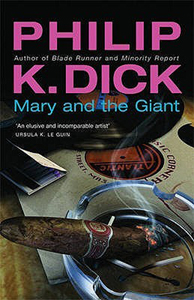“Mary and the Giant” (written in 1954, published in 1987) is a nice gender-swapped companion piece to “Voices from the Street” (1952, 2007), this time with Mary Anne Reynolds as the troubled young person. To use movies from 50 years after Philip K. Dick’s writing of the novels as points of comparison, “Mary” is the “Ghost World” to “Voices’ ” “The Good Girl.”
Like Thora Birch’s Enid in “Ghost World” – the 1990s comic made into a 2001 movie, one of my all-time favorites – 20-year-old Mary is troubled by not knowing what she wants in life. As such, she tests various waters in her small hometown of Pacific Park, Calif.
Anxious girl
At her record-store counter-girl job, she gets frustrated by not knowing as much about classical music as proprietor Joseph Schilling, who is 58. She wants to know it all, now. The word “anxiety” doesn’t come up in the novel, but I suspect Mary would be diagnosed with that condition.

“Mary and the Giant” (1987)
Composition year: 1954
Author: Philip K. Dick
Genre: Coming-of-age drama, romance
Setting: Bay Area, 1954
Help, asking for help, and the desire to help someone are all prominent themes in “Mary,” whereas those ideas are more buried in “Voices.” Because the person in need of help is a young woman, and because Dick rarely has a woman as his protagonist, this could be a controversial novel if the specifics are widened into more universal statements.
It’s not necessarily unfair to widen the scope, though, as “Mary” reads somewhat like an experimental novel. By writing about Mary, PKD is trying to understand women. He can’t totally understand them, but that’s OK because the book is about how men can’t totally understand women. In a way, the satisfaction of “Mary” comes from Schilling’s realization that he can only do so much to help Mary.
PKD shows an even defter character-building touch here than in “Voices,” with hardly any hugely dramatic moments. The notable exception is a masterfully written mid-book party scene that finds former photography model Beth dancing in a naked frenzy. Meanwhile, her husband, Carleton, lets his jealousy of their black host, Tweaney, seep out.
Casual racism
PKD understands and portrays the perspectives of the rabid partiers but also of wallflower Paul Nitz – the equivalent of Brad Renfro’s character in “Ghost World” — who desperately needs to leave the scene. The author is so good at showing casual, vindictive midcentury racism, as opposed to the societal or institutional kinds we’re more familiar with.
Because Tweaney has stirred Beth’s sexual display, Carleton is jealous of Tweaney, plain and simple. But it comes out as a vile racist rant because that behavior is acceptable – or was acceptable in the recent past – in American society.
“Mary” is shallow in some ways, but that’s often a feature rather than a bug because the novel captures the simplistic feelings of men toward certain women (the desire to love them, protect them, help them, and have sex with them). My main memory from my first reading years ago was that Mary is flighty and impossible to understand. On this reading, I noticed her condition of anxiety and the inability of the men around her to understand her.

Mary is her own person
Out of all of them, Joseph Schilling – he’s the titular giant, and his “Ghost World” equivalent is Steve Buscemi’s record collector — comes closest, despite the generation gap that puts him at a huge disadvantage. (“He could not possibly have come closer,” Schilling reflects as part of an excellent passage near the book’s end.)
Joseph engages in a brief sexual relationship with Mary that he’s not proud of or comfortable with; he’s “staggered” when a real-estate agent assumes they are father and daughter. But he ultimately does take on a fatherly position, outlining ideas – such as moving to the Bay Area proper – that might lead her toward success and happiness.
One issue that a reader might assume would be the most dramatic turns out not to be. It’s implied in the first scene with Mary’s dad, Edward, that he sexually abused her when she was younger. When we finally learn what happened, it’s not all that dramatic, although it’s not nothing.
It’s an example of mature writing that PKD does not conclude that Mary’s fear and anxiety come from her father abusing her. In his ruminations, Joseph speculates that that incident is part of it, but he and the author understand that nature and nurture both factor into people’s upbringings.
And it’s clear that Mary is her own person. “Inconsistent” might come to mind when describing her behavior, but there’s actually one consistent thing: She never does – at least not for long — what someone else suggests.
A feminist novel from PKD?
Some critics have called “Mary” a feminist novel, which is kind of amusing for an author whose status as a “breast man” is clear from his descriptions of women in pretty much any novel you pick up. For all but the most minor female roles, PKD describes women’s physical appearance through a decidedly male gaze. Heck, he equivocates women with cigarettes and alcohol – vices to be enjoyed by men – in the goofy 1964 short story “The War with the Fnools.”
Also, PKD gives a positive resolution for Nitz, the shy pianist who loves Mary from afar, perhaps because he wants the nice guy – rather than his flawed rivals Schilling (old), Tweaney (selfish) and Dave Gordon (Mary’s unobservant fiancé) — to acquire the desired object (Mary).
This contrasts with “Ghost World,” wherein all of Enid’s potential allies fade from the narrative until she is by herself, forced to find happiness alone or learn a harsh lesson about casually rejecting people – a flawed person, but definitely not an object. And the Mary-Paul happily-ever-after doesn’t quite jibe with Schilling’s on-point amateur analysis that Mary needs to mostly be alone to be happy.
But hey, PKD was a multi-faceted man and writer. And if “Mary and the Giant” is his experimental attempt to write about a woman, the experiment is a success. He doesn’t understand Mary even after 232 pages, but he does create a memorable and fully alive human being.

